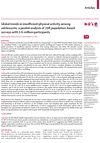Abstract: Efficacy of School‑Based Interventions for Improving Muscular Fitness Outcomes in Adolescent Boys
Background
It has been reported that boys’ and girls’ physical activity (PA) levels decline throughout adolescence. Boys are
at risk of physical inactivity during adolescence; however, in intervention research, they are an under-represented group relative to girls. It is suggested that the school environment may be central to developing interventions that support adolescents in meeting the current PA guidelines. The aim of this systematic review and meta-analysis was to investigate the efficacy of school-based physical activity interventions for improving muscular fitness outcomes in adolescent males.
Methods
This systematic review and meta-analysis followed the preferred reporting systems for meta-analyses guidelines and was registered on PROSPERO (Registration number: CRD42018091023). Eligible studies were published in English within peer-reviewed articles. Searches were conducted in three databases, with an additional grey literature search in Google Scholar. Studies investigating MF outcomes were included.
Results
There were 43 data sets identified across 11 studies, from seven countries. Overall methodological quality of the studies was moderate-to-strong. Interventions targeting MF evidenced a small-to-medium effect (g=0.32, CI 0.17, 0.48, p < 0.00). Subgroup analyses of MF delivery method resulted in small-to-medium effects: upper limb MF measures (g=0.28, 95% CI −0.02, 0.58, p=0.07), lower limb MF measures (g=0.28, 95% CI 0.09, 0.68, p = 0.03), combined MF activities (g=0.24, 95% CI −0.04 to 0.49, p=0.05), plyometric activities (g=0.39, 95% CI 0.09, 0.68, p=0.01), body weight (g=0.27, 95% CI −0.10, 0.65, p=0.15), and traditional MF methods (g=0.43, 95% CI 0.09, 0.78, p=0.01).
Conclusions
School-based interventions which aimed to increase muscular fitness outcomes in adolescent boys demonstrated small-to-moderate effects. Traditional and plyometric methods of resistance training appear to be the most effective form of PA delivery in adolescent males. More quality research is required to assess the impact of MF delivered in the school environment to inform future intervention design.



Responses